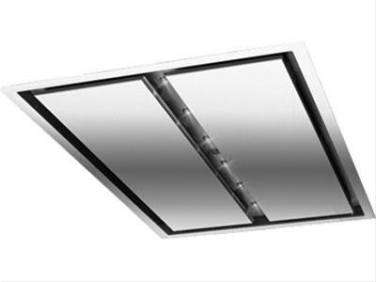The least-fun thing to think about when designing a kitchen? Our vote goes to the range hood, that hardworking, often noisy machine that can hog precious space and ruin sight lines. That’s why we were excited to see a new, discreet option starting to appear in open kitchens with center islands. Meet the ceiling-mounted surface vent. Blink and you might not even notice it.

What are these vents?
They’re remote-controlled hoods that are inset in ceilings, so that only a stainless-steel frame and panel (often of dark glass detailed with lights) is visible. Positioned directly over a cooktop, the vents, like all hoods, are there to absorb cooking odors and grease. Available in a range of rectangular sizes and increasingly popular in Europe, these unobtrusive versions are just starting to make inroads in the US.

Where do they work–and what’s the catch?
The majority of these vents are ducted to the outside, so in most cases, you need to be in a house to have one in your kitchen. (On top of venting considerations, many states have strict requirements for the amount of “makeup air” channeled in in proportion to what goes out, and not all recessed ceiling vents are strong enough to meet these codes. Local appliance specialists can fill you in on the details.)
For a ceiling-mounted recessed kitchen vent to be most effective, it needs to be larger than the cooktop that’s under it–for a 36-inch cooktop, for example, use a 42- or 48-inch hood—and to be close enough to do its job: The ideal distance between ceiling vent and stovetop varies, but for optimal effectiveness, Matt Avery of Faber tells us no more than four feet is recommended.
If you have a powerful commercial-style range and do a lot of frying, one of these models isn’t likely to do the trick. But if you do regular cooking and there isn’t a great distance between stove and vent—a too tall ceiling can be remedied by inserting the vent into a soffit—this open-plan option may be the perfect problem solver.

Who makes ceiling-mounted recessed vents?
A number of familiar brands have started introducing flush ceiling vents, including Best (see its Cirrus models), Miele, Futuro Futuro, Falmec, Zephyr, and Faber.

Are there other unobtrusive kitchen vent options?
Yes, under-the-cabinet hoods are another popular choice (and can work in apartments) as are downdraft hoods, that rise in the back of the range at the press of a button. The latter, we’re told, work particularly well with induction cooktops.

Go to our Kitchen Appliance posts for more advice, including:
- 10 Easy Pieces: Compact Refrigerators
- Remodeling 101: Beyond Gas vs. Electric: A Quick Guide to Kitchen Stoves and Cooktops
- 10 Easy Pieces: Ceiling-Mounted Kitchen Range Hoods
Finally, get more ideas on how to evaluate and choose a new kitchen hood or vent in our Remodeling 101 Guide: Kitchen Hoods & Vents.
N.B.: This post is an update; the original story ran on October 13, 2015.
Frequently asked questions
What are ceiling-mounted recessed kitchen vents?
Ceiling-mounted recessed kitchen vents, also known as ceiling vent hoods or downdraft vents, are ventilation systems designed to remove cooking odors, steam, and smoke directly from the kitchen. They are installed in the ceiling, typically above a cooking surface, and are an alternative to traditional range hoods.
How do ceiling-mounted recessed kitchen vents work?
Ceiling-mounted recessed kitchen vents work by drawing air downwards through a vent opening in the ceiling. They use powerful fans and filters to capture and remove cooking fumes, odors, and airborne particles. The vented air is then exhausted either outside the building or recirculated through additional filtration.
What are the advantages of ceiling-mounted recessed kitchen vents?
The advantages of ceiling-mounted recessed kitchen vents include their discreet appearance, as they are integrated into the ceiling, and their ability to provide effective ventilation in open kitchen layouts where traditional range hoods may obstruct views or interfere with the design. They also offer flexibility in installation options.
Are ceiling-mounted recessed kitchen vents suitable for all kitchen configurations?
Ceiling-mounted recessed kitchen vents are best suited for kitchens with open layouts, islands, or peninsula configurations. They are particularly useful when traditional wall-mounted range hoods are not feasible or desired due to design constraints or obstructed views.
Can ceiling-mounted recessed kitchen vents handle the same ventilation capacity as traditional range hoods?
Ceiling-mounted recessed kitchen vents can provide similar ventilation capacity as traditional range hoods, but it depends on the specific model and manufacturer. It's important to choose a vent system with adequate airflow and suction power to effectively remove cooking odors and smoke from your kitchen.
Are ceiling-mounted recessed kitchen vents noisy?
The noise level of ceiling-mounted recessed kitchen vents can vary depending on the specific model and fan speed settings. Some models are designed to operate quietly, while others may produce more noticeable noise. Consider the noise factor when selecting a vent system and consult with manufacturers for noise specifications.
Can ceiling-mounted recessed kitchen vents be installed in any ceiling type?
Ceiling-mounted recessed kitchen vents can be installed in various ceiling types, including flat ceilings and sloped ceilings. However, the installation process and requirements may differ based on the ceiling structure. It's important to consult with professionals to ensure proper installation and compatibility.
Do ceiling-mounted recessed kitchen vents require professional installation?
Installing ceiling-mounted recessed kitchen vents typically requires professional expertise, especially when it comes to electrical wiring, ductwork, and ceiling modifications. Professional installation ensures proper functioning, compliance with building codes, and safe operation of the vent system.
Are there any maintenance requirements for ceiling-mounted recessed kitchen vents?
Ceiling-mounted recessed kitchen vents require regular maintenance, including cleaning or replacing filters, checking and cleaning the vent opening, and ensuring proper operation of the fan. Refer to the manufacturer's guidelines for specific maintenance instructions.
Can ceiling-mounted recessed kitchen vents be used in conjunction with other ventilation options?
Yes, ceiling-mounted recessed kitchen vents can be used in conjunction with other ventilation options, such as windows, skylights, or additional ventilation systems, to enhance air circulation and exhaust capabilities in the kitchen.








Have a Question or Comment About This Post?
Join the conversation